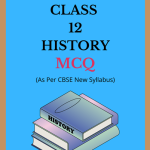NCERT Class 12 History MCQ Chapter 10 Colonialism and The Countryside Solutions to each chapter is provided in the list so that you can easily browse through different chapters NCERT Class 12 History MCQ Chapter 10 Colonialism and The Countryside and select need one. NCERT Class 12 History MCQ Chapter 10 Colonialism and The Countryside Question Answers Download PDF. NCERT History MCQ Class 12 Solutions.
NCERT Class 12 History MCQ Chapter 10 Colonialism and The Countryside
Also, you can read the NCERT book online in these sections Solutions by Expert Teachers as per Central Board of Secondary Education (CBSE) Book guidelines. CBSE Class 12 History MCQ Solutions are part of All Subject Solutions. Here we have given NCERT Class 12 History MCQ Part – I: Themes in Indian History, History MCQ Part – II: Themes in Indian History, History MCQ Part – III: Themes in Indian History. NCERT Class 12 History MCQ Chapter 10 Colonialism and The Countryside Notes, NCERT Class 12 History MCQ Notes for All Chapters, You can practice these here.
Colonialism and The Countryside
Chapter: 10
| THEMES IN INDIAN HISTORY (PART – III) |
| MCQ |
1. The people who mainly lived in the region of Rajmahal hills were called:
(a) The Paharias and the Santhals.
(b) The Land lords and outsider settlers.
(c) The Zamindars and Rentiere.
(d) None of the above.
Ans: (a) The Paharias and the Santhals.
2. The sources that tell us about histories of the Rajmahal hills area include:
(a) Revenue records and surveys.
(b) Journals and accounts left by surveys.
(c) Travellers accounts and reports produced by enquiry commissions.
(d) All the above mentions sources.
Ans: (d) All the above mentions sources.
3. Colonial rule was first established in:
(a) Awadh.
(b) Hyderabad.
(c) Bengal.
(d) Punjab.
Ans: (c) Bengal.
4. Raja (literally king) was a term that generally used to designate powerful:
(a) Zamindars.
(b) Izaredars.
(c) Jagirdars.
(d) Iqtedars.
Ans: (a) Zamindars.
5. The land estates of the Zamindars could be auctioned in the conditions:
(a) Failing to pay the revenue regularly.
(b) Failing to improve the agricultural land.
(c) Abusing the raiyats and their female members of the family.
(d) Failing to give Nazaranas and precious gifts to Taluqdars of his zamindars.
Ans: (a) Failing to pay the revenue regularly.
6. Village headmen were also called:
(a) Jotedars and mandals.
(b) Ryots and semi-ryots.
(c) Amins and amlahs.
(d) None of the above.
Ans: (a) Jotedars and mandals.
7. In Burdwan above pending suits for arrears of rent payment in 1798 were over:
(a) 30,000.
(b) 40,000.
(c) 60,000.
(d) 50,000.
Ans: (α) 30,000.
8. Jotedars, was a class of rich:
(a) Peasants.
(b) Zamindars.
(c) Big and powerful labourers.
(d) Company’s officials.
Ans: (a) Peasants.
9. For sharecroppers we can use correct world:
(a) Only adhiyars.
(b) Bargadars.
(c) Both (a) and (b).
(d) None of the above.
Ans: (c) Both (a) and (b).
10. The Report which was submitted in 1813 to the British Parliament is called:
(a) Eighth scheduled.
(b) The Fifth Report.
(c) The Sixth Report.
(d) The Seventh Report.
Ans: (b) The Fifth Report.
11. Maharaja Mehtab Chand (1820-79) helped the British during:
(a) The Santhal rebellion.
(b) The 1857 revolt.
(c) During the santhal rebellion and the 1857 revolt.
(d) None of them.
Ans: (c) During the santhal rebellion and the 1857 revolt.
12. Buchanan was a:
(a) Physician.
(b) Philosopher.
(c) Viceroy.
(d) Queen Victoria’s relative and known.
Ans: (a) Physician.
13. Who was Augustus Cleveland?
(a) The Governor general of the company.
(b) The Collector of Bhagalpur.
(c) The most powerful English Zamindar of Rajmahal hills.
(d) None of the above.
Ans: (b) The Collector of Bhagalpur.
14. By 1832 a large area of land was demarcated as:
(a) Damin-i-Koh.
(b) Santhal property and Zamindaris.
(c) Paharias property and Zamindars.
(d) Twenty four Kos.
Ans: (a) Damin-i-Koh.
15. Sidhu Manjhi was the leader of the:
(a) Bhil rebellion.
(b) Santhal rebellion.
(c) Kol rebellion.
(d) The Paharias rebellion.
Ans: (b) Santhal rebellion.
16. Rentier is a term used to designated people who live on:
(a) Rental income from property.
(b) Rential income from Benami land only.
(c) Rental income from Government official residence.
(d) None of the above.
Ans: (a) Rental income from property.
17. Under ryotwari system the lands were re-surveyed:
(a) Never.
(b) every 30 years .
(c) every 10 years.
(d) every 20 years.
Ans: (b) every 30 years.
18. Regulating Act was passed by the British Parliament in:
(a) 1873.
(b) 1773.
(c) 1673.
(d) 1905.
Ans: (b) 1773.
19. Find out from the following pairs which is correctly matched:
(a) The Fifth report to British: 1815.
(b) The fifth Report: 1002 pages.
(c) Maharaja Mehtab Chand: Raja of Burdwan.
(d) East India Company established its rule in Bengal: In the mid 1760.
Ans : (b) The fifth Report: 1002 pages.
20. Which one of the following were collected by Paharias in the Rajmahal hills for food?
(a) Resin.
(b) Silk cocoons.
(c) Mahu.
(d) Wood.
Ans: (c) Mahu.

Hi! my Name is Parimal Roy. I have completed my Bachelor’s degree in Philosophy (B.A.) from Silapathar General College. Currently, I am working as an HR Manager at Dev Library. It is a website that provides study materials for students from Class 3 to 12, including SCERT and NCERT notes. It also offers resources for BA, B.Com, B.Sc, and Computer Science, along with postgraduate notes. Besides study materials, the website has novels, eBooks, health and finance articles, biographies, quotes, and more.




